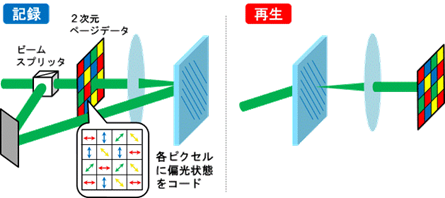Polarization holographic memory
Polarization Hologram
Polarization hologram is a hologram that records the polarization state of light as well as the amplitude and phase. Therefore, the reconstructed polarization depends on the recorded signal. When the signal is s-polarized and the reference is p-polarized, for example, s-polarized light is reconstructed with p-polarized probe wave (Fig.1). A specific characteristic of polarization-sensitive materials enables this kind of hologram to record polarization states. Permittivity of these media is modulated according to exposing polarization. The conventional theory of polarization holography, which discusses reconstructed polarization by determining the Jones matrices of media, assumes the paraxial approximation, and can be applied only when the beam crossing angle is quite small. Accordingly, we proposed the new one which is applicable to arbitrary optical geometry. In this theory, we describe the modulation of mediumfs permittivity tensor in phenomenological way.

Figure1FPolarization Hologram
Polarization Holographic Memory
As mentioned above, a polarization hologram can record polarization states. Now we are trying to use this advantage to increase the storage capacity of holographic memory. In the case of conventional holographic memory, each pixel of two-dimensional data page represents 1/0 by on/off of light. In contrast, polarization states can be recorded for each pixel in polarization holographic memory, which enables multi-level recording.

Figure2FPolarization Holographic Memory
- Kazuo
Kuroda, Yusuke Matsuhashi, Ryushi
Fujimura, and Tsutomu Shimura
Theory of Polarization Holography
Opt. Rev. Vol.18, No.5, pp.374-382 (2011).